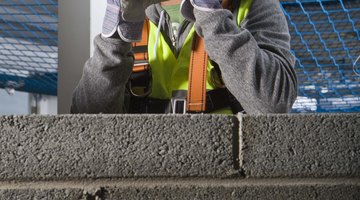How to Replace Basement Cinder Block Walls
While poured concrete is the standard for most residential basements today, in some areas, cinder block foundations still are the norm. Being a masonry product, cinder blocks are hard and structurally sound when the contractor reinforces them with steel and fills them with concrete or mortar.

Replacing basement cinder blocks is a major project that requires excavation, and the use of support beams and house jacks. Unless you’re experienced in dispersing weight loads, this is a job best left to the pros.
Structural Support
Before you can start removing the old cinder blocks, you’ll have to support the structure the existing blocks are now supporting. This involves installing structural beams in the basement that span the same distance as the portion of the wall you will be removing. Hydraulic house jacks will hold the beams in place. The jacks must sit on concrete or blocking that does not permit the jacks to shift.
Excavation
Digging out the exterior of a basement with a shovel is possible, but it’s not recommended. An experienced backhoe operator can remove the soil quickly right next to the foundation, creating a trench to access the cinder blocks. Before digging, call your local utility providers to ensure that no power lines or pipes lie beneath the area to excavate. In some communities, you also may need to get a permit before starting the project, and the excavator may have to dig a stair-type trench that is safer than a straight-side trench, but entails digging up a good portion of the yard next to the foundation. You also may be required to install safety supports in the trench.
Removing the Blocks
Cinder blocks install in a stair-step pattern, and you’ll remove them the same way. The old tried-and-true way to remove the blocks is to knock them out with a sledgehammer, but that can become tiresome quickly. The pros use rotary hammers and demolition hammers, which are available for rent from construction rental stores. Using them, however, is akin to using a jackhammer, so recruit a strong worker for this task. If you’re removing only a portion of damaged blocks, you’ll need a circular saw, fitted with an abrasive blade, to cut the mortar joint smoothly beneath the last blocks you remove. You should find horizontal steel bars between each row of blocks, and you might find vertical bars in the middle of the blocks. A reciprocating saw will sever these bars.
Laying New Blocks
Lay the new blocks in the same pattern as the old ones. You’ll need steel rebar, which fits into grooves between the courses, and local code may require vertical bars, as well. Use mortar specifically formulated for structural use. Standard mortar used to lay bricks on the side of a house is not sufficient. Fill the voids in the blocks with mortar or concrete mix as you go. Once you fit the uppermost cinder blocks in place, beneath the house sill, wait a couple a couple of weeks before you backfill the soil next to the foundation. You may then remove the house jacks and support beams.
The Drip Cap
- While poured concrete is the standard for most residential basements today, in some areas, cinder block foundations still are the norm.
- Being a masonry product, cinder blocks are hard and structurally sound when the contractor reinforces them with steel and fills them with concrete or mortar.
- Hydraulic house jacks will hold the beams in place.
- The old tried-and-true way to remove the blocks is to knock them out with a sledgehammer, but that can become tiresome quickly.
- Use mortar specifically formulated for structural use.
- Once you fit the uppermost cinder blocks in place, beneath the house sill, wait a couple a couple of weeks before you backfill the soil next to the foundation.
References
Writer Bio
Glenda Taylor is a contractor and a full-time writer specializing in construction writing. She also enjoys writing business and finance, food and drink and pet-related articles. Her education includes marketing and a bachelor's degree in journalism from the University of Kansas.
Photo Credits
- Jupiterimages/BananaStock/Getty Images
- Jupiterimages/BananaStock/Getty Images
More Articles



